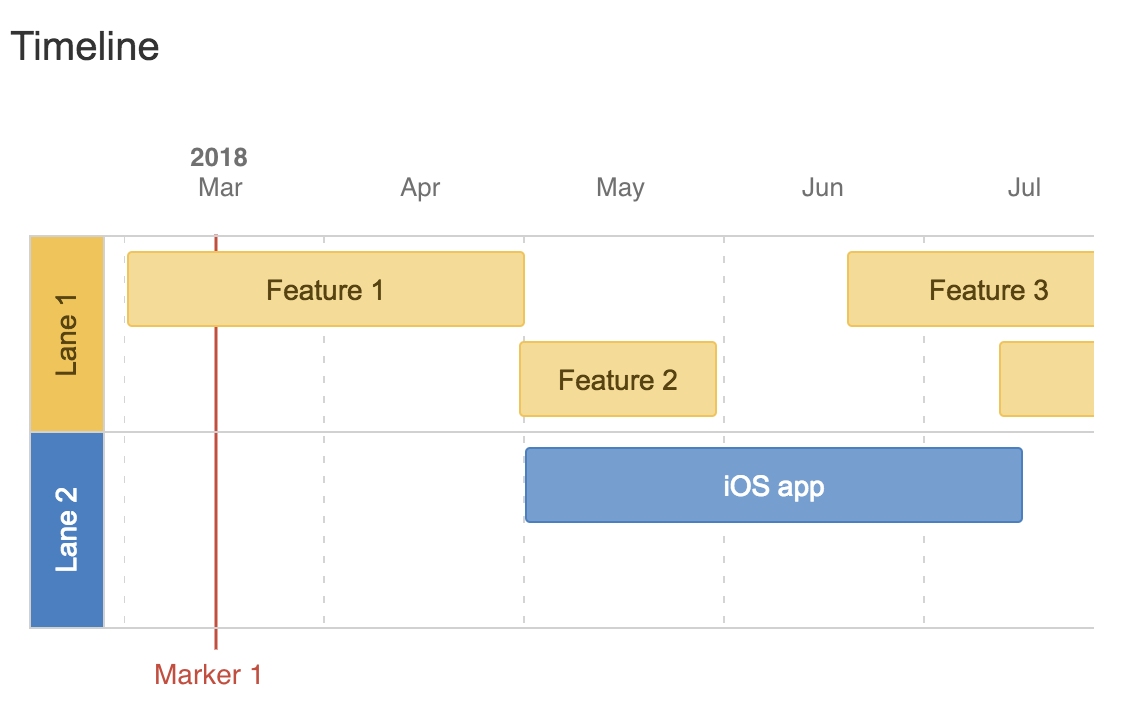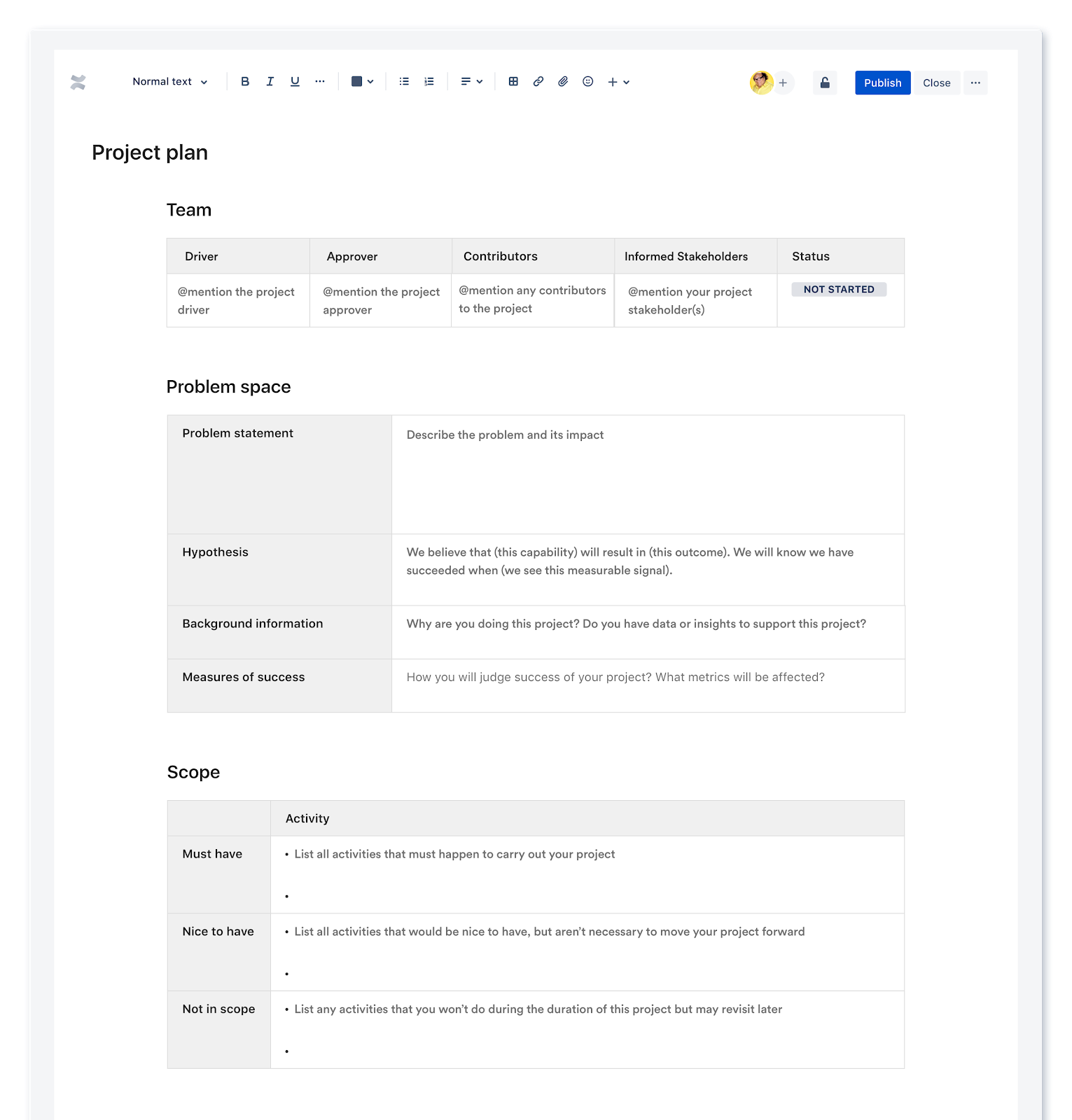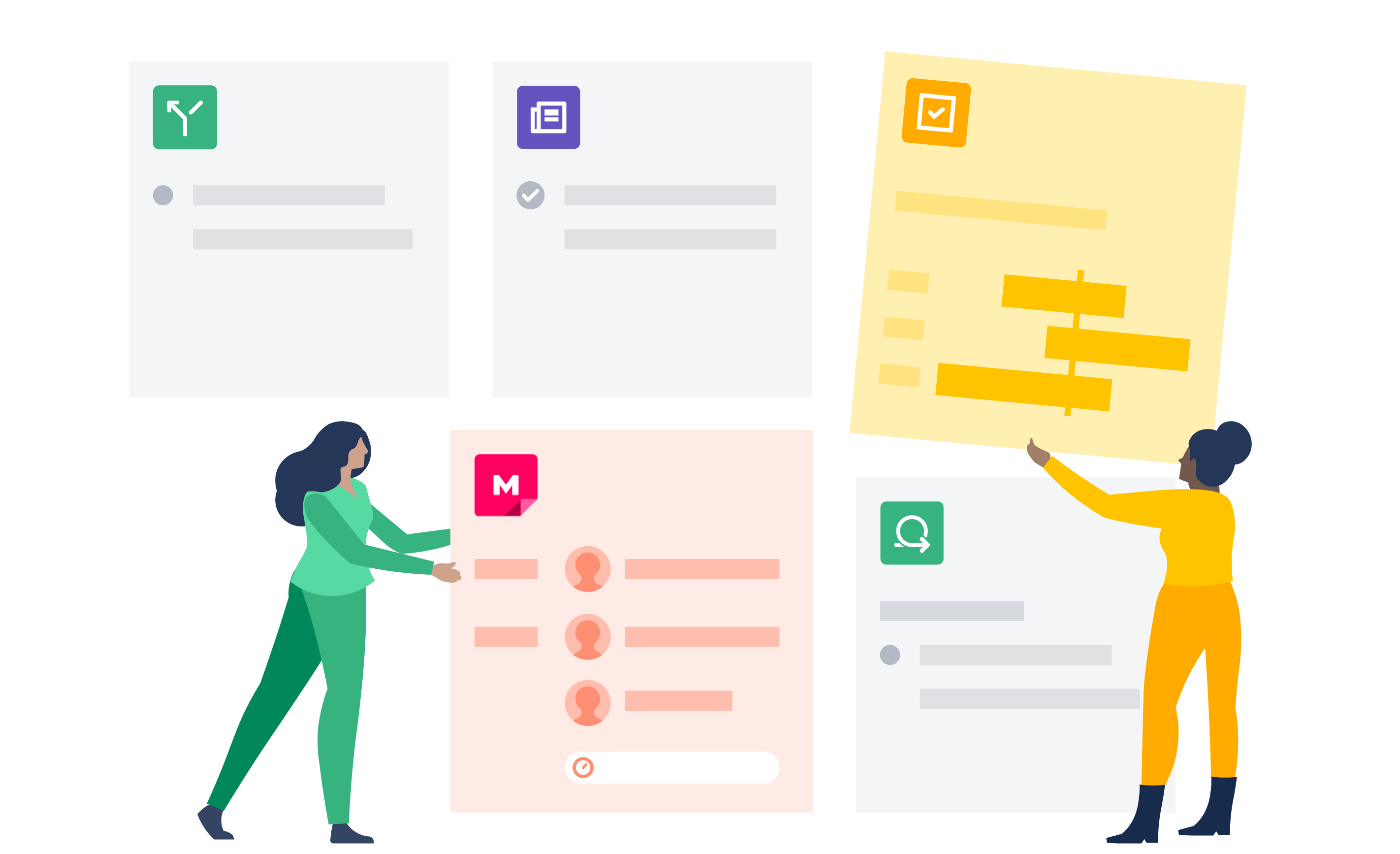シンプルで周到なプロジェクト計画を作成する方法
優れたプロジェクト計画は、単にいつ何をすべきかを記したリストではありません
「プロジェクト計画」と聞くとほとんどの方が、スケジュール、つまりいつ何をすべきかを記した長いリストを思い描きます。けれども、これはほんの一部分にすぎません。優れたプロジェクト・マネージャーは、解決しようとしている問題だけでなく、プロジェクトのスコープ、成果物、リスク、依存関係も網羅した計画を作成して、プロジェクトを成功させるための道筋を描きます。
プロジェクト計画がないと、チーム・メンバーは複雑な迷路の中で迷子になることがあります。どこから始めればよいかわからなかったり、さらに悪いことに、自分のタスクが全体像の中でどのように位置づけられるかを明確に理解せずに業務に没頭したりする可能性があります。
プロジェクト計画立案とは
プロジェクト計画とは、プロジェクトの完了に必要な目的、スコープ、活動を定義するプロセスです。明確な目標を設定し、リソースを特定し、コストを見積もり、プロジェクトを成功させるためのロードマップを作成することがプロジェクト管理の基本面です。
プロジェクト計画は、効果的な実行、監視、管理の基礎を築きます。このプロセスでプロジェクト・マネージャーとチームは労力とリソースを調整でき、それにより不確実性が減り、プロジェクトを予定どおりに予算内でデリバリーできる可能性が高まります。
プロジェクト計画とは
プロジェクト計画は、プロジェクト計画立案プロセスの具体的な成果です。これは、目標と目的、スコープ、スケジュール、リソース要件、リスク、依存関係など、プロジェクトの主要な要素を概説する包括的なドキュメントです。
プロジェクト計画は、すべての関係者のロードマップとして機能し、プロジェクトの目的、マイルストーン、期待される成果を明確に理解できるようにします。チーム・メンバーを選択し、必要なプロジェクト計画ツールを指定し、成功するために必要な手順を詳しく説明します。
優れた構成のプロジェクト計画は、プロジェクトの実行を導くだけでなく、プロジェクトのライフサイクル全体を通して全員に情報を提供し、足並みを揃えるためのコミュニケーション・ツールとしても機能します。
プロジェクト計画のメリット
- 明確性と協調:プロジェクト計画では、プロジェクトの目的とスコープについて共通の理解が得られ、チーム・メンバーと関係者の全員が共通認識を持つことができます。この明確性により、誤解や矛盾する期待を減らせます。
- リソース割り当て:人的、財政的、物的を問わず、必要な資源を特定して割り当てるのに役立ちます。これにより、リソースの利用が最適化され、割り当てが過剰になるのを防止できます。
- リスク管理:プロジェクト計画により、潜在的なリスクの特定と評価が可能になります。リスクに備えることで、プロジェクト・チームはリスクに積極的に対処し、それを軽減できます。
- 時間管理:優れた構成のプロジェクト計画には、マイルストーンとタスクの依存関係を含むタイムラインがあるため、プロジェクト・スケジュールの管理と締め切りの遵守が容易になります。
- コスト管理:プロジェクトの計画段階でプロジェクトのコストを見積もることで、組織は経費をより効果的に追跡し、管理できます。
- コミュニケーションの向上:プロジェクト計画は、すべての関係者に常に情報を提供し、全員がプロジェクトの進捗状況、変更点、課題を認識できるようにするコミュニケーション・ツールとして機能します。
- 品質保証:計画には、プロジェクトが質の高い結果を生み出すようにするための品質基準とプロセスを含めることができます。
- 説明責任の促進:プロジェクト計画ではタスクの所有者を指定し、特定の活動の責任者を明確にして、説明責任を促進します。
- 効率的な意思決定:計画は意思決定プロセスを定義するのに役立ち、プロジェクト中に発生した課題への対処や重要な意思決定をより容易にします。
プロジェクト計画プロセス(ステップを含む)
段階的なアプローチでプロジェクト計画を立てることは、不要な作業のように思えるかもしれませんが、堅実で成功する戦略を構築するためには重要です。計画プロセスに進む前に、少し時間をとってチーム、組織、利用可能なリソース、プロジェクトの目標について考えてみます。プロジェクト計画段階の初めから、チームとの共通の理解を深めることが重要です。
ステップ 1:プロジェクト計画をマップとして考える
マップを描く際には、次の問いに対する答えを考えると役立ちます。
- 目標は何ですか?
- プロジェクトが完了したことを、どうやって知れますか?
- このマップに従うのは誰ですか?
- 彼らがその過程で通過するマイルストーンは何ですか?
- どのような障害に直面する可能性がありますか?
代わりの経路はありますか?
ステップ 2: 関係者を知る
プロジェクト管理プロセスで発生する可能性のある、組織政治、扱いの難しい人物、議論の焦点になる可能性のあることを把握します。Software Technology Support Center のプロジェクト・マネージャーで PMP(プロジェクト管理プロフェッショナル)である Larry W. Smith は、関係者分析の重要性を強調しています。Smith 氏によると、全員がプロジェクトの成功を願っていても、たった 1 人の影響力を持つ関係者のニーズを満たすことを忘れれば、よく練られた計画でも台無しになる可能性があります。
Smith 氏は、時間を取って次のことを行うように推奨しています。
- プロジェクトの関係者は誰かを明確にする
- 関係者が期待することと影響の度合いを理解する
- プロジェクトを進めながら、同僚と関係者からのフィードバックをどのように取り入れるかを決定する
- すべてのニーズと期待を、リスク計画とリスク対応アクティビティに関連付ける
- プロジェクトに関するコミュニケーション戦略すべてを入念に計画する
明確なコミュニケーションの重要性はどんなに強調してもしすぎることはありません。アトラシアンの常駐プロジェクト・リーダー・エキスパートである Bernie Ferguson が、プロジェクトの最初の段階で関係者とコミュニケーションを取り始めるのはそのためです。
「私たちは、プロジェクト・ポスターの手法を使用して、チーム・メンバーと関係者の間で共通の理解を築いています。何に取り組むのか?顧客とビジネスにとっての価値は何か?なぜこれが正しい解決策であると考えるのか?チームのロードマップを実際に進める前に、これらすべての問いの答えに対するフィードバックを収集します」—Bernie Ferguson、アトラシアン
ステップ 3: 楽観的な考えを捨てて、タイムラインを詳細に策定する。
PM(プロジェクト・マネージャー)がよく犯す間違いは、楽観的に考えすぎることです。PM は、可能な限り最良の結果に焦点を当てるのではなく、発生する可能性のある問題と、それがプロジェクト管理タイムラインにどのように影響するかを検討すべきです。
重要なデュー・デリジェンスを行ったり、「事前分析」ワークショップを開催したり、主要な関係者と 1 対 1 のミーティングを実施したりすることは、潜在的な障害を特定する素晴らしい方法です。
他のプロジェクト・マネージャーに、同様のプロジェクトの計画にどのくらい時間がかかったかを聞いて、タイムラインの概略を作成することを検討します。共同で作業することが分かっているチームとミーティングをして、特定のプロジェクト・タスクを実行するのにどの程度時間がかかるのかを把握します。プロジェクト管理ツールを使用して、古いプロジェクト・スケジュールがないか、プロジェクト・アーカイブを検索します。

コミュニケーションの意義を繰り返して、その重要性を改めて強調します。プロジェクトの詳細を関係者全員に知らせます。やはり、関係者は知りたくなると思うからです。簡略化されたガント・チャートは、全員が簡単に理解できるようにプロジェクトのタイムラインを視覚化するための効果的な方法です。
ステップ 4:友人や同僚を参加させる
プロジェクト マネージャーであるあなたには、プロジェクト計画を提示する(そして、最終的にはプロジェクトを実行する)責任があります。しかしこれは、自分の席にこもって書き物をする作業ではありません。プロジェクト計画を立てる際には、主要な関係者全員を常に参加させる必要があります。連絡はなるべく絶やさないようにしてください。彼らが素晴らしいリソースであることが分かるでしょう。
チームの考えを集めてブレインストーミングすることで、意義のある結論にすばやく到達できます。チームのコラボレーションは、共同体のサポート意識を育み、それがより良いプロジェクト計画につながります。
アトラシアンでは、テンプレートを使用して計画プロセスに伴うオーバーヘッドを削減し、プロジェクト計画のベスト・プラクティスに不可欠な議論を促進しています。プロジェクト計画テンプレートは、関係者が考慮していなかった可能性のあるプロジェクト管理の側面について考えるようにするための優れたツールです。
プロジェクトに適したエレベーター・ピッチを用意することと、周到で効果的な計画を立てることはまったく別の仕事です。実を言うと、プロジェクトのリスクと依存関係をマッピングするのはあまり楽しいことではありません。アトラシアンの強力なテンプレートと有用なプロンプトにより、プロジェクト・マネージャーはプロジェクト計画の作成について系統的に考えることができ、見落としが減り、生産性が向上します。

ステップ 5:目標とプロジェクト・スコープを考える
具体的に何を解決しようとしているのかを明確な言葉で定義した、問題の説明を作成します。次に、問題を解決することで何が起こると考えられるかを明示した仮説を立てます。続いて、プロジェクトの背景と、それを裏付ける関連データやインサイトについて簡単に説明します。最後に、プロジェクトの成功を測るために使用する主な指標を決定します。これらの成功指標は、計画の方向性と焦点を形作るさまざまな側面に影響を与える可能性があります。
チーム メンバーに対して、あれば便利であるものや、不要なものではなく、実際に必要としているものを尋ねます。計画プロセスの早い段階で、明示的に除外されている内容を含め、プロジェクトのスコープを明確に理解することで、関係者の誤解を招くようなリスクを最小限に抑えます。これは、プロジェクト貢献者に対して適切な時間配分を決定するのにも役立ちます。この明確性により、プロジェクトのスコープに変更が生じた際に、それを特定して管理することが容易になります。
ステップ 6:予期しない事態を予測する
ほとんどのプロジェクト計画には、予算、プロジェクト・スケジュール、スコープに関する詳細が含まれています。ただし、優れた計画は、次のようなプロジェクトに関する重要な問いに対する答えも示します。
- リソース:プロジェクトにはどのような種類のスキルが必要ですか?そのスキルを提供できるのは誰ですか?予算はいくらありますか?
- 決定事項:誰が推薦しますか?誰がリクエストを承認または却下しますか?
- コミュニケーション:進捗状況や障害の伝達を行う担当者は?
- リスク:チーム・メンバーは何に気を付ける必要がありますか?脅威の記録と追跡のプロセスはどのようなものですか?
- レビュー:プロジェクトをリリースする前に、どのようにフィードバックを収集しますか?
- 承認:他にこのプロジェクトを承認する必要があるのは誰ですか?最終的な意思決定者は誰ですか?
タイミング:チーム・メンバーの作業スケジュールはプロジェクトのタイムラインに合っていますか?どのようにして締め切りを選びましたか?
計画で、これらの各課題の詳細を掘り下げる必要はありませんが、予期せぬ問題が多数生じることなく、プロジェクトを円滑に実施できるだけの情報は提供する必要があります。
チェックマーク ヒント: プロジェクトに関する確実な意思決定を適時に行うための DACI 手法を使用します。
ヒント: プロジェクトに関する確実な意思決定を適時に行うための DACI 手法を使用します。
ステップ 7:プロジェクト管理アプローチを選ぶ
ほとんどの PM は、プロジェクト管理にウォーターフォール・アプローチまたはアジャイル・アプローチのどちらかを選択します。アジャイル・アプローチは、プロジェクトの計画、要件、結果を継続的に評価する反復プロセスを利用して、迅速に結果を出します。この方法では、時間とリソースは固定したものと見なします。
ウォーターフォール・アプローチは、線形で順番に実行されるプロセスとなり、プロジェクトはステージごとチームごとに進められます。この場合は、スコープが固定されていると見なされるが、タイミングとリソースは変更可能です。
ステップ 8: 計画を書いてレビューする
すべての質問に回答してすべての議論を行い、大量の付箋に書き込んだら、ついにプロジェクト計画の作成に着手します。選択する言葉、フォーマット、デザインのいずれも、シンプルなものにしてください。
ここでは、どのような計画にも含まれるべき、役に立つ詳細をいくつか紹介します。
- プロジェクト名
- 実施日
- 予算
- 計画の目標
- 重要なマイルストーンと期待される測定可能な影響
- 各タスクの予定開始日と完了日
- 個別のタスクの所有者を強調するコールアウト
- 何が行われるべきかを明確に示す、タスクの詳細とメモ
遅延を防ぐための、互いに依存関係にあるリスクおよびタスク (またはチーム) のコールアウト
プロジェクト計画が完成したら、まだ執筆プロセスに関わっていない人にレビューを依頼してください。第二の目を持つことは、自然なヒューマン・エラーを見つけるのに役立ちます。
チェックマーク ヒント:各タスクの規模を見積もる際には、細部にこだわりすぎないようにしてください。これらは経験則に基づいた推測であることを忘れないでください。
ヒント:各タスクの規模を見積もる際には、細部にこだわりすぎないようにしてください。これらは経験則に基づいた推測であることを忘れないでください。
ステップ 9:計画を周りの人と共有しましょう!
プロジェクト計画が確定し、十分に検討されたら、積極的に関与する個人や、常に情報を得る必要がある関係者と計画を共有します。車輪が動き出すエキサイティングなプロジェクト・キックオフの準備をしましょう。変化や課題はどのプロジェクトにも不可欠な部分であることを認識し、それらに対処する準備をしておくことが重要です。
プロジェクトのライフサイクル全体を通して、計画を確認しながら進めます。プロジェクトの中核となる要素、対象となるスコープ、合意したステップに集中します。このアプローチにより、予期せぬ展開に直面した場合でも、確実に軌道に乗り、プロジェクトを正常に遂行できる可能性が高まります。
プロジェクト計画の例
以下は、マーケティング・キャンペーンのプロジェクト計画の簡素化された例です。
プロジェクト名:春の新製品発売キャンペーン
- プロジェクトの目標と目的:
- ブランドの視認性を 20% 向上させます。
- 3 か月以内に 1,000 件の見込み客を生み出します。
- 春のシーズン中、売上高を 15% 増加させます。
- スコープ:
- オンラインとオフラインの一連のマーケティング資料を作成します。
- 新しい製品ラインを立ち上げます。
- デジタル広告キャンペーンを実施します。
- プロジェクトのスケジュール:
- フェーズ 1(1 か月目と 2 か月目):キャンペーン戦略とコンテンツ制作。
- フェーズ 2(3 か月目):発売とマーケティング展開。
- リソース:
- マーケティング・チーム(メンバー 4 名)。
- 広告と資料の予算 $50,000。
- リスク:
- 屋外イベントに影響を与える予測不能な天候。
- 市場の競争は価格競争につながります。
- 依存関係:
- 製品開発の完了(キャンペーン開始前)。
- マーケティング資料の入手可能性(広告を出す前)。
- 品質保証:
- 質の高いコンテンツを確保するための定期的なレビューとフィードバック・セッション。
- タスク所有者:
- キャンペーン戦略:Sarah
- コンテンツ制作:John
- 製品発売:Emily
広告キャンペーン:Mark
この計画例では、プロジェクトの目標、スコープ、タイムライン、リソース、リスク、依存関係、品質基準を網羅しており、キャンペーン全体を通じて関係者やプロジェクトのチーム・メンバーにとって貴重な参考資料になります。
効果的なプロジェクト計画の立案
プロジェクト管理の分野では、包括的でよく構造化されたプロジェクト計画がチームと関係者をプロジェクトの成功に導く羅針盤となります。プロジェクト計画は単なるタスクのチェックリストではなく、プロジェクトの目的を定義し、リソースを割り当て、リスクを評価し、成功へのロードマップを提供する複雑なプロセスです。
プロジェクト・マネージャーは、思慮深く段階的なアプローチをとることで、プロジェクトのライフサイクルを通じて、明確性、協調性、適応性を育むことができ、最終的にはプロジェクトを期限内・予算内に遂行する可能性を高められます。
